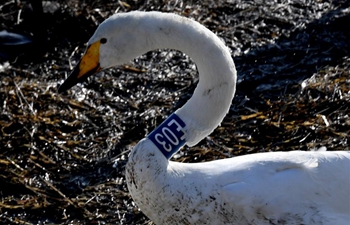BERLIN, Nov. 26 (Xinhua) -- Cars in Germany, the Eurozone's largest economy, produced a total of 115 million tons of Carbon Dioxide (CO2) in 2017, an increase of six percent compared to 2010, official figures published on Monday by the Federal Statistical Office showed.
According to the Wiesbaden-based government statisticians, one cause for the increasingly negative environmental footprint of German passenger vehicles was identified by the Federal Statistical Office on Monday in trend towards more powerfully-motorized cars. Whereas newly registered cars had an average motor performance of 97 Kilowatt (kW) in 2010, the figure had risen by 16 percent to 111 kW in 2017. During the same period, the share of CO2 emissions accounted for by cars with a motor performance above 100 kW grew from 36 percent to more than 50 percent.
The Federal Statistical Office further noted that the number of vehicles increased by 10 percent between 2010 and 2017 while their combined mileage rose by nine percent. Even though the average fuel consumption fell by around three percent in the past seven years, total fuel consumption consequently still increased by six percent to 46 billion liters of fuel.
The increase in fuel consumption was most pronounced for diesel vehicles with a motor performance of more than 100 kW (plus 69 percent), a finding which reflected growing concerns in Germany over the environmental impact of large diesel SUVs with regards to their CO2 and nitrogen oxide (NOx) emissions. The total consumption of highly-motorized petrol vehicles rose as well (plus 15 percent) but fell by nine percent for the category as a whole between 2010 and 2017.
The statisticians calculated that the increased motor performance of German passenger vehicles resulted in an absolute rise in CO2 emissions by 8 million tons. Larger vehicle numbers and higher mileage produced caused an additional 6 million tons of CO2 to be emitted. Lower average fuel consumption lowered the amount of CO2 in the air by 7 million tons and was hence only able to partially offset the other two factors.
In October, European Union (EU) member states set themselves a goal to reduce CO2 emission limits by 35 percent for new passenger vehicles and by 30 percent for light-duty utility vehicles. Germany is home to the EU's largest domestic car making sector and has recently admitted that it will most likely fail to meet its own climate policy targets for a 40 percent CO2 emission reduction between 1990 and 2020.












